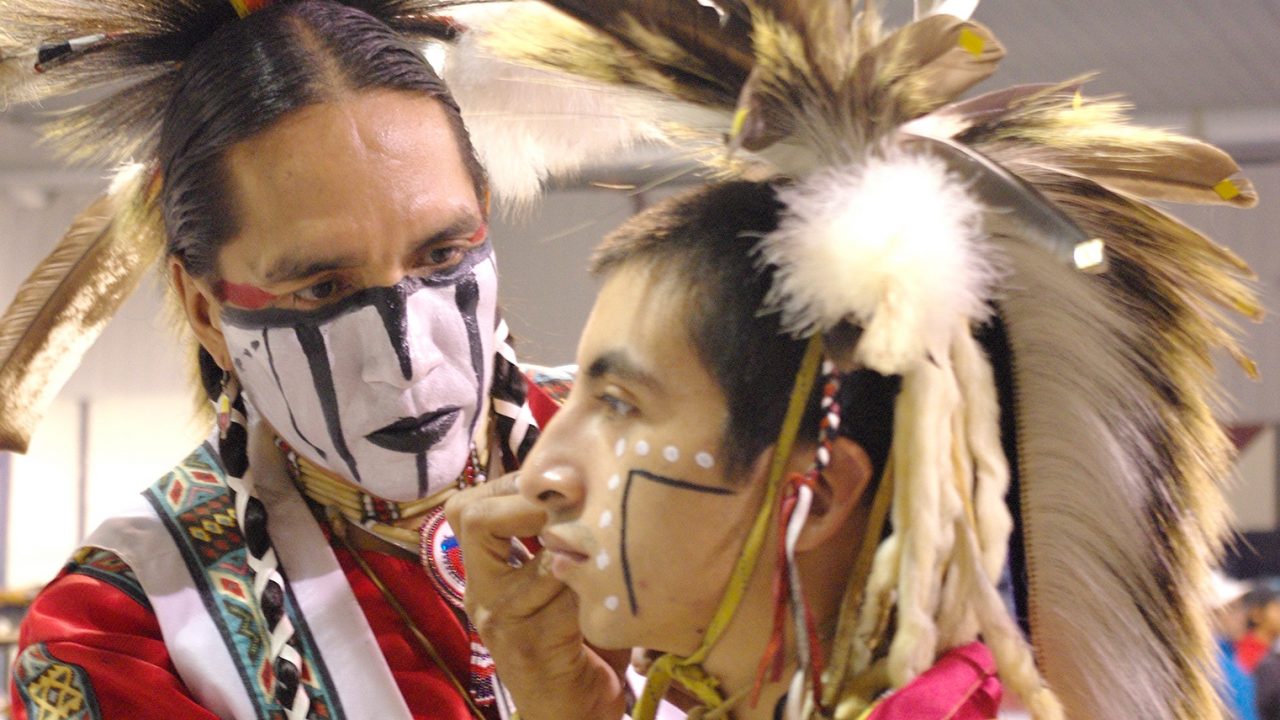
Mini-Lesson for Red Path
Mini-Lesson for Red Path
Mini-Lesson for Red Path
School Subjects:
- History/Politics
- Identity/Society
- Dance
- Music
Recommended Ages: 12-14
Red Path, Thérèse Ottawa, provided by the National Film Board of Canada
Overarching Question: Can the resurgence of Indigenous cultural practices, once outlawed by forced-assimilation policies, nurture healing and wellness within individuals, communities and society?
Educational Synopsis: In Red Path, a young man who’s been on a path of self-destruction, increasingly disconnected from his culture, is faced with grieving the loss of his biological mother. This loss sets the youth on a renewed path of healing, happiness and hope when he reconnects with his original community and culture. His journey symbolizes the importance of health and wellness for generations of Indigenous nations that have endured pain and suffering due to harsh forced-assimilation policies.
Round 1: Reflect, Discuss, Share Circle
INQUIRY AND THINGS TO CONSIDER
Under the Indian Act, from 1906–1951 “Indians” were prohibited from appearing in any public dances, shows, exhibitions, stampedes or pageants while wearing traditional regalia. Reflect, discuss and share thoughts about how the above enforced policy may have had long-lasting effects on Indigenous Peoples’ sense of self-worth and identity.
Consider the intergenerational effects of this policy on the participants included and mentioned in this film.
Clip #1 (2 min 54 s)
Step 1. If you are able to, sit the students down in a circle or a U-shape.
Step 2. Explain the steps and begin the following process.
Step 3. Present the students with the inquiry question and information on things to consider.
Step 4. Independent quiet moments of thoughtful reflection. (2 mins.)
Step 5. Pair students with the person sitting directly beside them. Have students share their reflections with the person beside them. (4–6 mins.)
Step 6. Going clockwise, have students pop up from their seats, one after the other in consecutive order, and share one to three words that describe their thoughts and feelings on the topic. (5–7 mins.)
Summary:
Consider what the intentions of the newly formed government may have been when they decided to make wearing traditional regalia illegal. Consider what the immediate consequence would have been for a First Nations person caught wearing regalia without permission. Consider how this form of cultural control would have immediate and generational effects on individuals and communities.
The style of regalia for powwow is tailored to the type of dance. There are several types of dances that are included in powwow. Each dance has a story to tell.
Round 2: Reflect, Discuss, Share Circle
The Indian Act declared the Potlatch and other cultural ceremonies illegal from 1884–1951. Consider how the demonizing and criminalization of cultural gatherings, such as the powwow, would have had a long-lasting negative effect on First Nations people’s sense of community, belonging, self-worth and identity.
Consider how the intergenerational impacts may have had an effect on the main character.
Clip #2 (2 min 17 s)
Step 1. Continue sitting in a circle or U-shape. The same process will take place but with a new topic for reflection, discussion and sharing.
Step 2. Explain the steps and begin the following process.
Step 3. Present students with the inquiry question and information on things to consider.
Step 4. Independent quiet moments of thoughtful reflection. (2 mins.)
Step 5. Pair students with the person sitting directly beside them. Have students share their reflections with the person beside them. (4–6 mins.)
Step 6. Going clockwise, have students pop up from their seats, one after the other in consecutive order, and share one to three words that describe their thoughts and feelings on the topic. (5–7 mins.)
Summary:
It was illegal for First Nations people to practise their cultural ways of being, knowing and doing. Powwows are one distinct gathering that many nations partake in. Ceremonies such as the Potlatch, which is a gathering with regalia, dance, and food and wealth distribution, were also outlawed. Beautiful artworks passed down for generations were often confiscated or burned. If individuals were caught partaking in ceremonies or celebrations, they were persecuted in various ways, including being placed in jail. The policies, although amended, have had long-lasting negative impacts on individuals and nations. This oppression, along with the loss of identity and a sense of belonging, has had many negative social consequences, which has given rise to negative attitudes towards Indigenous Peoples.
One reason ceremonies are performed is to celebrate transitions in life, such as the changing of seasons or rites of passage from one stage of life to the next (e.g., puberty). Ceremony and celebration are rooted in the love of family, community, land and relationship with all living things.
Round 3: Reflect, Discuss, Share Circle
Clip #3 (1 min 10 s)
INQUIRY
How is the process of making and wearing regalia, as well as dancing in powwow, symbolic of the young man deviating from a path of self-destruction and entering a path of healing and wellness? Consider how connecting with his culture helps the youth lay a path for a more positive future, for himself and his family.
Consider what kinds of emotions and feelings are roused in the young man when he wears the regalia, feels the music and dances. Does this cultural gathering seem like it is something that is positive or negative for individuals, communities and society?
Step 1. Continue sitting in the circle or U-shape. The same process will take place but with a new topic for reflection, discussion and sharing.
Step 2. Explain the steps and begin the following process.
Step 3. Present students with the inquiry question and information on things to consider.
Step 4. Independent quiet moments of thoughtful reflection. (2 mins.)
Step 5. Pair students with the person sitting directly beside them. Have students share their reflections with the person beside them. (4–6 mins.)
Step 6. Going clockwise, have students pop up from their seats, one after the other in consecutive order, and share one to three words that describe their thoughts and feelings on the topic. (5–7 mins.)
Summary:
The intergenerational fracturing of cultural connections that encourage health and wellness is apparent in the dark phase of this young man’s life. Early in life, he did not have a choice on being disconnected from family, community and culture. The process of grieving his mother mirrors his grieving over his disconnection from culture. The process of wearing and making regalia, as well as dancing, is healing; helping repair the wounds of a loss of identity. His actions help him to flourish on a path of wellness. The powwow emanates colour and energy that can be seen as symbolic of hope, happiness and healing. This young man’s reconnection with culture can be seen as symbolic on a societal scale.
Take Action
Although many amendments have been made to the Indian Act, research other components of the Act that resulted in long-lasting damage to Indigenous Peoples’ sense of well-being. Consider whether it is important for individuals other than Indigenous people to understand the lasting psychological and physical damage caused by policies such as the Indian Act. What types of strategies could be used to help the general population become more understanding of the social context of Indigenous Peoples in Canada? How can celebrating Indigenous original ways of knowing and doing contribute to society in a positive way?
Step 1. Research policies of forced assimilation that have been amended in the Indian Act. Try searching “21 things you may not know about the Indian Act” to get started. Ensure that the author of the research material is an Indigenous person.
Step 2. Create a class set of Did You Know fact cards that relate to policies of forced assimilation that have been amended in the Indian Act. Ensure that the authors of the research material are Indigenous people.
Step 3. Research positive Indigenous traditional cultural practices related to ceremonies, celebrations, the family, child rearing and community. You may want to focus research on nations based on the area where you and your students are located. There are many nations within Canada, for example, Cree, Anishnabe, Dene and Haudenosaunee. Ensure that the author of the research material is an Indigenous person.
Step 4. On one side of each of the Did You Know fact cards created by your class, write an example of a positive cultural practice.
EXAMPLE OF A FACT CARD:
Side 1 (front): Did you know that at one time in Canadian history, First Nations were prohibited from dancing?
Side 2 (back): Did you know there are many types of dances included at a powwow? The jingle dance is a dance for hope and healing.
Step 5. Once the set of cards is completed, share a card once a day or once or week in a school news broadcast or on social media. Students can also create copies of the cards to share with family and friends.
Pour lire cet article en français, cliquez ici.
Crystal Clark is Cree/Dene/Métis and originally from Fort McMurray, Alberta. Her educational background includes a Master of Educational Technology, a BEd, a BFA and a New Media diploma. She studied Indigenous writing and visual art at the En’owkin Centre. Crystal is also a recipient of a Prime Minister’s Teaching Achievement Award, a BC Festival of the Arts Media Scholarship, an Esquao Award for Education, and a Peace Hills Trust art award. She is an educator, an artist and, most importantly, a mother.
Discover more Mini-Lessons | Watch educational films on NFB Education | Watch educational playlists on NFB Education | Follow NFB Education on Facebook | Follow NFB Education on Pinterest | Subscribe to the NFB Education Newsletter



